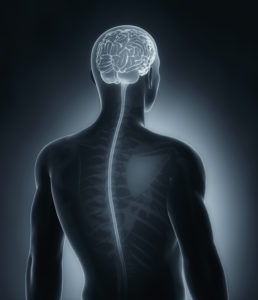New study finds brain’s properties determine most risk for chronic pain

Why do some people develop chronic pain following an injury while others do not? The question has long puzzled scientists and doctors alike. Now, a new study led by researchers at Northwestern University Feinberg School of Medicine and the Rehabilitation Institute of Chicago (RIC) has found that certain anatomical properties of the brain, and not the initial injury, determine the most risk of a patient developing chronic pain.
The findings were published in the journal Brain.
Today, chronic pain is deemed an epidemic in the United States, affecting 100 million Americans. It is commonly believed that a condition such as chronic back pain is the consequence of either ongoing inflammation of the back muscles or a manifestation of injury to major peripheral nerves of the spine.
“While simple, the logic of addressing problems at the site of an injury to remove pain has resulted in only limited success,” said senior study author Marwan Baliki, ’09 PhD, ’12 GME, an assistant professor of Physical Medicine and Rehabilitation at Feinberg and research scientist at RIC. “The central processes of chronic pain have largely been ignored, so our research team set out to better understand the brain’s role.”
The researchers conducted the first longitudinal brain imaging study tracking patients following an acute injury to the back. As part of the study, they followed 159 patients for three years as their pain either ceased or persisted. They found that patients who developed chronic pain had a smaller hippocampus and amygdala compared with those who recovered and healthy subjects. The hippocampus is the primary brain region involved in memory formation and retention, while the amygdala is involved in the processing of emotions and fear. In addition to changes in size, these regions also showed differences in connections to the rest of the brain, particularly to the frontal cortex, an area involved in judgment.
“Together, these brain properties accounted for 60 percent of the variance for pain persistence and, for the first time, have enabled a mechanistic model for chronic pain development,” said first author Etienne Vachon-Presseau, PhD, a visiting postdoctoral fellow in the Department of Physiology. “As the anatomical risk factors were stable across three years, they were presumably hardwired and present prior to the onset of back pain.”
[pullquote]The study’s results challenge long-standing views of the science of pain, establishing that the gross anatomical properties of the brain determine the most risk for developing chronic pain.[/pullquote]
The study’s results challenge long-standing views of the science of pain, establishing that the gross anatomical properties of the brain determine the most risk for developing chronic pain.
“These results pave the way for the development of novel and distinct approaches for the prevention and treatment of chronic pain,” said A. Vania Apkarian, PhD, professor of Physiology and senior author of the study.
Additional Feinberg study authors include Pascal Tétreault, PhD, Bogdan Petre, Lejian Huang, PhD, research assistant professor of Physiology, Sara Berger, Alexis Baria, PhD, Ali Mansour, MD, James Griffith, PhD, research assistant professor of Medical Social Sciences, and Thomas Schnitzer, MD, PhD, professor of Physical Medicine and Rehabilitation and of Medicine in the Division of Rheumatology.
The study was supported by National Institute of Neurological Disorders and Stroke grant NS035115; the Canadian Institutes of Health Research; Swedish Council for Working Life and Social Research grant 2011-0627; and Uppsala University.
Members of the media, for more information about this story, please contact: Megan Washburn at 312-238-6016 (mwashburn@ric.org)






